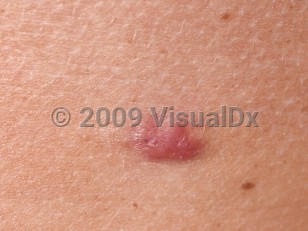Eccrine poroma
Alerts and Notices
Important News & Links
Synopsis

Eccrine poromas occur only in the skin and most often present as a solitary, skin-colored or slightly erythematous, smooth or verrucous papule. They are less commonly pigmented or pedunculated. Poromas are usually less than 2 cm in diameter and are slow growing or fixed in size. Ulceration may occur, especially when over pressure points. Extremities, specifically palms and soles, are the most common sites, but they can occur anywhere; cases have been reported on the trunk, face, and neck. Rarely, patients may develop multiple poromas, or eccrine poromatosis. This condition is characterized by varying numbers of papules, more than 100 in some cases, that may be distributed widely or confined to the palms and soles.
Sweat gland tumors are thought to represent as little as 1% of primary cutaneous lesions, and poromas comprise only 10% of these. Poromas generally occur in adults over the age of 40, with no predilection for sex or ethnicity, and there is no apparent familial component. No definitive pathogenesis has been described, but cases have been reported as occurring in association with radiation exposure, trauma, pregnancy, hypohidrotic ectodermal dysplasia, and Bowen disease. They may also develop secondarily within a nevus sebaceus. Eccrine poromatosis has been reported in patients with lymphoproliferative disorders that have been treated with chemotherapy. Onset has varied from during the chemotherapy until years after.
Rarely, malignant eccrine poroma, or porocarcinoma, develops, either de novo or by transformation within a benign eccrine poroma. These lesions have metastatic potential.
Codes
D23.9 – Other benign neoplasm of skin, unspecified
SNOMEDCT:
399985004 – Eccrine poroma
Look For
Subscription Required
Diagnostic Pearls
Subscription Required
Differential Diagnosis & Pitfalls

Subscription Required
Best Tests
Subscription Required
Management Pearls
Subscription Required
Therapy
Subscription Required
Drug Reaction Data
Subscription Required
References
Subscription Required
Last Updated:08/28/2019

